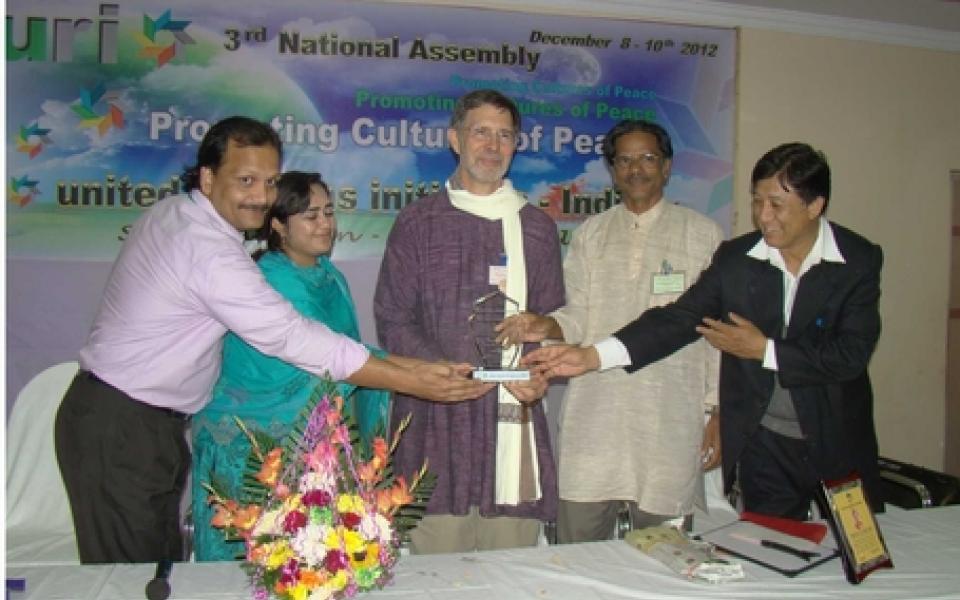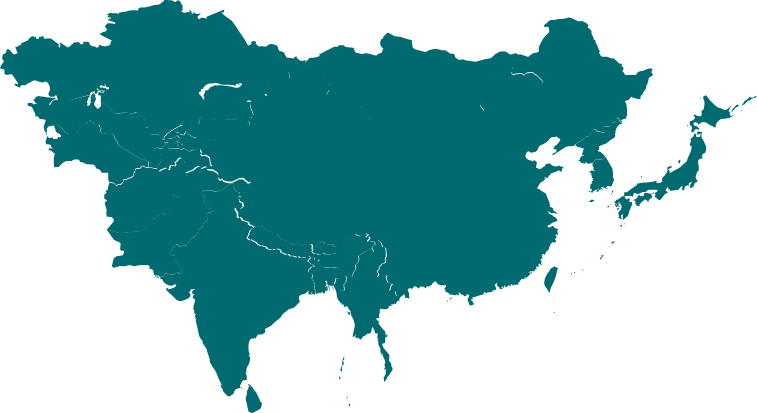
Dear Friends,
Greetings of love and peace from Shantiniketan.
I’m continuing with Monday morning’s zonal reports, which I began in my previous posting. Abraham Karickam reported on the South Zone, noting that there are 50 CCs, the majority in his state of Kerala, but expanding into other states and also into Sri Lanka and Bangladesh, which are connected with India's East Zone.
He noted that in the early years of his tenure the focus was on creating new CCs. At a certain point, he felt it was critical to shift the focus to consolidating the growth that had taken place. He now feels that the consolidation work has yielded good fruit and that it is time to place renewed focus on growth.
I asked him how he had come to the conclusion that it was time to focus again on growth. He explained that the original shift from growth to consolidation was motivated by a desire to help CCs deepen their commitment and expand their capacity for impactful action. In doing that work, he has come to recognize that in the same way that there are different kinds of people, there are different kinds of CCs.
Some CCs are very active, thriving on finding new projects and more effective ways to engage the projects they choose. Other CCs aren’t particularly active and no amount of input seems to change that. They are perfectly happy doing something now and then. And then there are CCs in between these two varieties.
Abraham said he had come to realize that it didn’t make much sense to put a great deal of time and energy into the CCs that were perfectly content with a low level of activity. They should be appreciated, valued, included, invited, but the coordinator shouldn’t judge success by being able to change their basic nature, unless they began to express a desire to change. Therefore, the coordinator’s primary focus and energy should be on those CCs striving to make an ever-greater
impact, to learn new skills, to explore new partnerships.
All CCs are important, but these more active CCs will have a far greater impact when it comes to making URI’s purpose and mission real in the world. With this learning, Abraham said, I feel it is time for a renewed focus on growth, and that focus should aim at creating/attracting CCs that have the promise of being active. As is so often the case with Abraham’s learnings, I feel this is an important learning for all URI leaders to reflect upon.
Qutub Kidwai noted that there are 17 CCs in the West Zone, 15 of them with very active leaders and members. Among the CC programs she noted:
- Food for Learning – providing for basic human needs and engaging in dialogue about basic values and self-esteem in the Mumbai slums; engaging all CCs in monthly meetings around a common theme, currently sharing stories from sacred texts; peacebuilding in the often explosive Gujurat State, with a special effort of engaging women as peacebuilders;
- Saving the Girl Child – engaging maulanas, pandits and priests in articulating and promoting a religious approach to valuing girls that will help change consciousness and behavior, and also providing trauma counseling and education for women who have practiced female feticide and/or girl-child-killing; women’s legal empowerment; and preparing to launch the national pilot project on gender awareness/issues in 2013.
Biswadeb Chakraborty likely mentioned how many CCs there are in the East Zone, but I neglected to record that. I did manage to record at least some of the rapid-fire list of activities he offered: Women’s Welfare Society; a mosque that offers computer training to young people of all faiths; blood donation camps; a village computer literacy project with one computer for 100 students; health and medical distribution camps; teach-ins on human rights and other key issues in tribal villages; nutritional programs; providing plants to schools to encourage ecological education and practice among students; observing the International Day of Peace and World Interfaith Harmony Weekwith tree planting and peace marches.
He said the zone is particularly proud that Hariyali CC won an environmental seed grant for work to counteract deforestation, and for having hosted the 2012 global assembly in Mayapur and this year’s India assembly.
Following these impressive reports, we heard about the work of individual CCs in greater detail, with the reports divided by an abbreviated lunch break (don’t the breaks always get abbreviated in the rush to accomplish everything on an assembly agenda?). Originally, five CCs had responded to Biswadeb’s many requests to let him know if they wanted to share about their work. Predictably, the enthusiasm generated by being together opened the floodgates and suddenly many
more CCs clamored for time to report.
Biswadeb handled this by giving priority to those CCs that had responded and then accommodating as many others as possible, to the extent of giving up on one important agenda item: Technology and Its Benefits – URI web access for CCs. But having given up this item, he was clear that we had to follow through with the rest of the agenda and some late-coming CCs would be unable to report. Everyone seemed to happily accept this compromise.
Since many of the reports were given in the presenter’s native language and since that language often was other than English, I couldn’t give a thorough report of these reports even if I wanted; but I can report that each person who spoke was clearly proud of the work of her/his CC and those listening were clearly glad to learn about what their URI colleagues from different parts of India were doing.
There was great interest in hearing about the wide range of work being done by CCs from tribal areas in the East Zone, with key areas being education, meeting basic needs, advocating for basic human rights, and being powerful defenders of the environment in the face of natural resource extraction by large companies, including deforestation and mining.
The report that seemed to generate the most excitement -- because it came with an offer and an invitation to an historic event -- was the report by Sadhvi Adityananda Saraswati from the Ganga Action Project, which has grown out of the Parmath Niketan Ashram in Rishikesh. With Qutub translating into Hindi, Mataji spoke in English about this important
work to clean the mother Ganga, focusing on the 6 T’s – Toilets, Trash, Trees, Taps, Tracks (railroad), Tigers. If any CCs located on the banks of the Ganges wanted to join the effort to install eco-toilets, she said, the toilets would be provided by the Ganga Action Project.
And she invited all CCs to send representatives of the first Green Interfaith Kumba Mela, coinciding with World Interfaith
Harmony Week in February. Overall, the Kumba Mela attracts 120,000,000. The Green Kumba Mela will be much, much, much smaller, but she offered accomodations and meeting space. This will be a workshop not a talkshop, she noted. We want to find actions we can take together on this critical issue.
Following these reports, Biswadeb presented a vision to help integrate URI work all over India. Key pieces of this vision were the creation of a 24-person (six from each zone; a great opportunity to promote the equitable participation of women and men) leadership team that would be trained to provide high capacity leadership to the next phase of
URI’s growth in India. He also spoke of expanding the India Leadership Team. He then asked the leaders from each zone to meet to determine a unifying focus for their efforts in 2013.
It was clear that this unifying effort would not take away from each CC’s right to determine its own work, but would offer a means for all CCs to feel part of a shared effort that could have greater and greater impact. Moving beyond 2013, the intention would be to have a shared unifying focus for all of India. In my mind this movement to a unifying focus is very much in the spirit of URI’s founding years, when people all over the world expressed two equal desires – to determine their own specific focus and way of working; and to be part of something much bigger that could have a larger impact that their individual efforts.
Following clearly engaging consultations (I must admit that I was surprised at how much energy and enthusiasm the groups had for this task near the end of the afternoon after two full days of work), each zone reported on its vision for a unifying focus. Each with a zonally unique approach, north, south and east zones all had work to heal and protect the
environment as their unifying focus.
The North Zone will focus on environmental education, especially on training teachers and sensitizing students about this important issue. They offer the vision of encouraging schools to have students raise flowers in pots to give them a greater sense of connection with the natural world. They also will ask for very brief reports after six months.
The South Zone will focus on safe water, using education and the media as tools to promote conservation and practices that help prevent pollution.
The East Zone will focus on deforestation and other resource extraction, and protecting water, land, the forest, and animals, as well as the human population. They noted that they have many small rivers flowing into the Ganges and will join the Ganga Action Project in that way. They expressed their gratitude to the GAP for creating the means for their smaller efforts to connect with a larger platform.
The West Zone noted that they are already united around the Save the Girl Child campaign, but will also add an effort to sensitize teachers about religion and caste issues. Key tools in this effort will be the PPP of the URI Charter and the Golden Rule poster, which they would like to see distributed to all schools.
Following enthusiastic applause for these reports, Rev. Kisku noted that the opportunity and challenge before us was to turn our talking into walking and our walking into working. Also, following on Swami Chaturvedi’s generous offer to sponsor the 2013 India Assembly, the group agreed to hold that assembly for three days instead of two – 15-17 November 2013. With that agreement, the main work of the assembly was accomplished.
The final item of business was listed as Honoring “Outstanding Peace Leader” & Closing Ceremony and Vote of Thanks. It turned out that I was the one to be honored (pictured above). I’ll leave it to others to provide any fuller account of that if anyone desires, and will only say that I was deeply moved by the outpouring of love, affection and appreciation from my colleagues.
We then had the opportunity to appreciate and thank all those who had done so much to make it possible for us to gather in this blessed location. I had the privilege of handing each person a bouquet of flowers and a small thank-you gift. With that, the assembly was formally concluded.
An engaging cultural evening with a formal program that evolved into a joyously inclusive time of free-form dancing, dinner, and many, many final conversations, planning sessions, bows, hugs and smiles took us well into the evening.
At 10:30 PM, Abraham and I were escorted to the train station and placed on an overnight train to Jaipalguri, where we would find a car to take us up, up, up to Darjeeling. But that is another story for another day, so I’ll end here with another quote from Tagore:
You can’t cross the sea merely by standing and staring at the water.
Love,
Charles
The Rev. Canon Charles P. Gibbs
Executive Director, United Religions Initiative
